2007 LA Show: VW Space-Up! Blue Fuel-Cell Concept
 The third installment of Volkswagen’s up! concept goes by the name space-up! blue. Concisely, the space-up! Blue is a fuel-cell powered version of the 5door space-up! prototype (see here) that appeared at the 2007 Tokyo Show in October. The LA Show car uses an electric motor which delivers 61 PS, turns at up to 10,000 times per minute and generates a maximum torque of 120 Nm.
The third installment of Volkswagen’s up! concept goes by the name space-up! blue. Concisely, the space-up! Blue is a fuel-cell powered version of the 5door space-up! prototype (see here) that appeared at the 2007 Tokyo Show in October. The LA Show car uses an electric motor which delivers 61 PS, turns at up to 10,000 times per minute and generates a maximum torque of 120 Nm.The zero-emissions space-up! blue draws its power from an array of twelve lithium-ion batteries with a total energy capacity of twelve kilowatt-hours (kWh). These batteries have a 65 mile (105 km) range before needing recharging. According to VW, the space up! blue can go up to a top speed of 75 mph (120 km/h) while it sprints from 0 to 62 mph (100 km/h in 13.7 seconds. -Continued after the jump
The cars batteries can be replenished either via an electrical outlet or by the Volkswagen high-temperature fuel cell. In the latter case, the prototype’s range is extended an additional 155 miles or 250 km, making it possible to drive up to 220 miles or 355 km in total on a single charge. Interestingly, VW’s microvan also utilizes solar panels on the roof which help supply up to 150 Watt of energy to the battery.
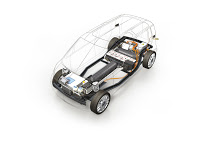
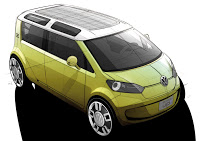
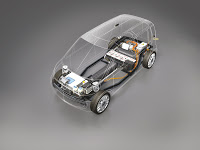
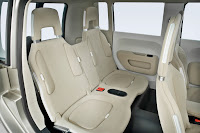
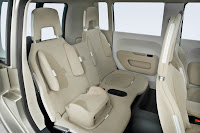

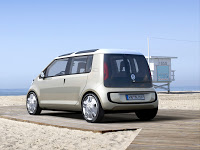



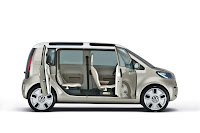
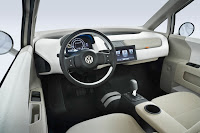

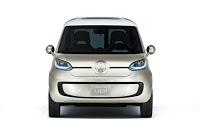



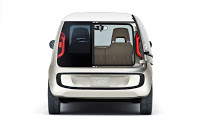
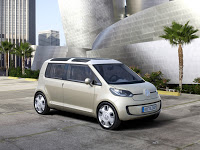
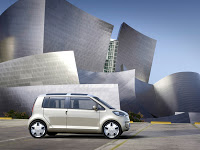
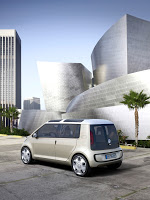
To the Point: The space up! blue
Clean Drive Revolution “Made in
Volkswagen presents the first car in the world with high-temperature fuel cell
space up! blue covers downtown distances with pure battery drive
Energy is "refueled" either via an electrical outlet or by the Volkswagen high-temperature fuel cell. In the latter case, the car’s range is extended an additional 155 miles. This makes it possible to drive up to 220 miles on a single "energy charge". Aside from this, the microvan utilizes another energy source: the sun. And indeed with a large solar panel on the roof. It supplies up to 150 Watt of energy that is also fed into the battery.
With its new high temperature fuel cell (HT-FC) Volkswagen is introducing a system that represents a turning point in research on fuel cells for mass production. That is because, the HTFC offers crucial advantages compared to all other fuel cell systems: considerably lower weight, significantly greater everyday utility, substantially lower price, and therefore clearly the better chances of becoming a reality someday as a mass produced technology. The high temperature fuel cell was developed at a dedicated research center founded by Volkswagen in
With its concept car being shown in
- Mercedes Announces Production Of Hydrogen-powered B-class F-cell
This is Mercedes-Benz's B-Class F-Cell, the company's first ever series production fuel-cell car. According to the German automaker, production will begin in late 2009 with the first of around 200 examples of the hydrogen-electric hybrid to be...
- Vw Testing Chinese Passat Lingyu Fuel-cell Vehicles In The States
Volkswagen of America announced today that it has 'imported' 16 Passat Lingyu fuel-cell vehicles from China to use in fleet demonstrations at the California Fuel Cell Partnership in Sacramento, California. These prototype fuel-cell vehicles that...
- Detroit Preview: Mercedes-benz Concept Bluezero
For the 2009 Detroit Auto Show in January Mercedes-Benz will be showcasing a trio of 'green' concept cars that will go into limited production next year. Based on a modified version of Merc's sandwich-floor platform used on the current A-...
- La Show: Honda Fc Sport Fuel-cell Design Study
Honda's best kept secret for the 2008 Los Angeles Auto Show goes by the name FC Sport and it's a hydrogen-powered, three-seat sports car concept. The design study utilizes Honda's V Flow fuel cell technology which is already deployed in the...
- Frankfurt Show: Hyundai I-blue Fuell-cell Electric Concept
Hyundai’s eco-friendly proposition for this year’s Frankfurt Show is a 2+2 Crosssover that goes by the name i-Blue Fuel Cell Ellectric Vehicle –yes, that’s the full name of the prototype. Developed at Hyundai's Design and...
